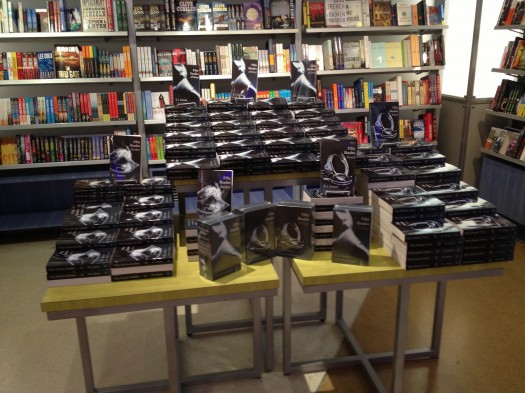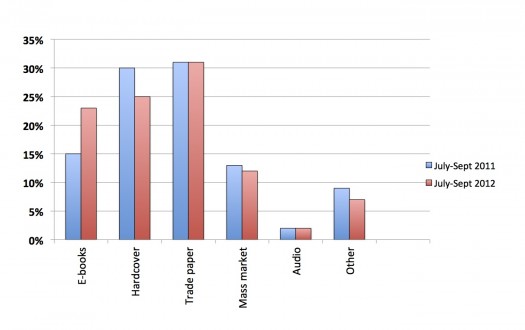
Oh Format, Where Art Thou?

A few years ago, when I was working for a major publishing house, I was sitting in a sales meeting to launch a new season of books when one of the National Accounts Managers (who sold that publisher’s books to Barnes & Noble) said of a particular title, “Can’t we just publish this as a trade paperback original? It’s the only way I can increase the buy.” I can still remember the disconcerted look on the editor’s face knowing that she would have to make an unpleasant phone call to an agent, and then speak to the author about switching formats. In my own mind, I was thinking: “Why is this a bad thing?”
While the majority of authors write books because they have a story to tell, they also crave the validation of, well, being a published author. So does it really matter if your book is published as a hardcover, trade paperback, or e-book? Does it matter if a book is initially published as an e-book, then perhaps as a trade paperback and hardcover? The short answer is: Yes, it does.
A quick glance at the New York Times bestseller lists for hardcover, trade paperback, and e-book fiction tells us a few things. Namely, that Fifty Shades of Grey is still selling really well in trade paperback and e-book formats. Take an even closer look at the e-book fiction bestsellers and you will find that romance and erotic fiction rule the roost. The hardcover fiction bestseller list, however, tells a much different tale of what people are reading. It is sprinkled with literary titles like Tenth of December by George Saunders and commercial titles from the likes of Brad Meltzer, John Grisham, and Dave Barry. Jump on over to the paperback trade fiction bestseller list, and there are a buffet of titles—something for everyone—from the Fifty Shades of Grey trilogy to The Paris Wife.
What may not be clear to most readers are the strategy and psychology behind the bestseller lists. Why do certain genres sell in a particular format while others don’t? There is no easy answer, but people who read commercial fiction (romance, thrillers, etc.) consume books. This means they are more likely to buy e-books because they don’t feel the need to keep a hardcover on their shelf. People who tend to buy literary hardcovers like to keep their books. It is this “consume” versus “keep” mentality among readers that creates such a disparity in sales among certain genres in their respective formats.
This is one of the reasons we don’t see a literary e-print, an imprint dedicated to bringing literary books to the marketplace in e-book format. But maybe this is changing. Just last week, it was encouraging to see Little, Brown in the UK launch Blackfriars, a digital-only imprint that will focus on new literary fiction and serious nonfiction. Publishers want new readers—and to grab the much-coveted eighteen- to thirty-four-year-old demographic—so they will have to create a bigger, better digital path to literary fiction.
Now, imagine for a second that you are an author who has written The Great American Novel and your agent is submitting it to editors at various publishing houses. You have envisioned a shiny new hardcover sitting atop bookshelves everywhere and then your agent awakens you from this daydream to tell you there are offers … BUT … publishers seem to be interested in either a trade paperback original or an e-book. Better yet, the publisher may want to publish an e-book version first, gauge sales, and then maybe publish a printed book. What is an author to do? Let’s break it down:
According to the American Association of Publishers 2012 Bookstats: In the overall trade sector (encompassing Fiction and Non-Fiction for Children, Young Adults and Adults), e-books’ net sales revenue more than doubled in 2011 vs. 2010. This significant growth was particularly fueled by e-books’ performance in the Adult Fiction segment where, for the first time, it ranked #1 for the year in net revenue among all individual print and electronic formats.
Bowker’s research shows that e-books sales are trending up; hardcover sales are trending down: See the 2011 vs 2012 comparison below.

Bowker’s research also showed that in September 2012: 11 percent of e-books bought were Romance; 23 percent of all books purchased were e-books; 24 percent of all book buyers bought e-books.
According to the Book Publishing Report’s consolidated analysis of the New York Times, USA Today, and Publisher’s Weekly bestseller lists, the romance category was the top-selling genre of 2012.
The Book Publishing Report also shows that there were 533 e-books on the New York Times bestseller list in 2012, which was higher than hardcover (526), paperback (526) and mass market (410). In all, e-books represented 26.7 percent of all formats represented on the New York Times bestseller list in 2012.
So, what is an author to do when the choice is to be published in trade paperback or e-book, but not hardcover? For some, the choice is complex because being published in hardcover (falsely) assigns a certain amount of stature to said author. In the past, a hardcover was considered a calling card for an author while a trade paperback was akin to a napkin on which you’d scribble your number. Times have changed, as has the consumer. In other words, the format that sells is the right format for the book. The format that is the best discovery vehicle for the book is the right format for the book.
While I agree that certain authors will always sell in hardcover (Jodi Picoult, Joyce Carol Oates, JK Rowling, David Baldacci, and James Patterson come to mind), there are numerous others who may find their books published strictly as trade paperbacks or e-books. This is an inevitable trend, and the perception within publishing that a trade paperback or e-book means an author is “less than” a hardcover author simply must change.
———
About the author: Kathleen Schmidt has over 15 years of experience in the publishing industry. Currently, she is CEO of KMSPR, a book publicity firm. Find her on Twitter: @Bookgirl96 or @kmspr.
